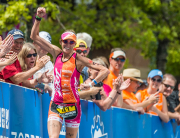 If you’ve spent any time around the Durata Training coaches chatting about training and racing I really hope (for your sake) that you did not talk about doing “base training”. Because if you did you probably saw us pull out a soap box from the nearest stand of scrub brush and enthusiastically articulate all the reasons you were wasting your time. This time of year cyclists, runners and triathletes start talking about doing base work. How they need to go out and spend significant amounts of time at very low intensities. When pressed about why they need to do this the responses range from “I need to build my aerobic engine and build mitochondria on long easy rides” to “If you go too hard early in the season you may burst blood vessels in your eyes” (I really did hear this once). The problem lies in that if you are not generating a physiological overload in your training then your body is never forced to adapt to a new stress and you never really get any better. For most of us we have a finite amount of time each day and week to train, with that it means we must make the most out of our precious training time, and for the majority of athletes long, easy base work is a waste of that time.
If you’ve spent any time around the Durata Training coaches chatting about training and racing I really hope (for your sake) that you did not talk about doing “base training”. Because if you did you probably saw us pull out a soap box from the nearest stand of scrub brush and enthusiastically articulate all the reasons you were wasting your time. This time of year cyclists, runners and triathletes start talking about doing base work. How they need to go out and spend significant amounts of time at very low intensities. When pressed about why they need to do this the responses range from “I need to build my aerobic engine and build mitochondria on long easy rides” to “If you go too hard early in the season you may burst blood vessels in your eyes” (I really did hear this once). The problem lies in that if you are not generating a physiological overload in your training then your body is never forced to adapt to a new stress and you never really get any better. For most of us we have a finite amount of time each day and week to train, with that it means we must make the most out of our precious training time, and for the majority of athletes long, easy base work is a waste of that time.
Though it is ingrained into the psyche of endurance athletes that you need substantial amounts of time at a “base” or “foundation” intensity the truth of the matter is that for an athlete that has been consistently participating in a given endurance sport for more than several months (much less years) doing “base” work is as an effective use of your training time as plucking daisies. This goes back to the overload principle. Physiological stresses must be progressively added to an athlete’s training program while permitting appropriate recovery in order to see positive training adaptations.
While it is important to take a few down and unstructured weeks from training, the build back up into focused progressive overload need not take months, in fact for most athletes it can begin right away provided the coach/athlete has planned out the training season to permit peaking and competitive periods. The problem is that often the rate of training load outstrips the biological adaptation of the body and the athlete becomes injured, peaks too early or burns out physiologically and/or psychologically. Runners and multisport athletes tend to have higher incidences of injury due to the weight bearing/impact nature of running. Great care must be taken in the progression of an athletes training so that they stay healthy enough to get in the needed consistency for success. It’s a fine balance but it is something that deserves significant thought and discussion of between coach and athlete.



